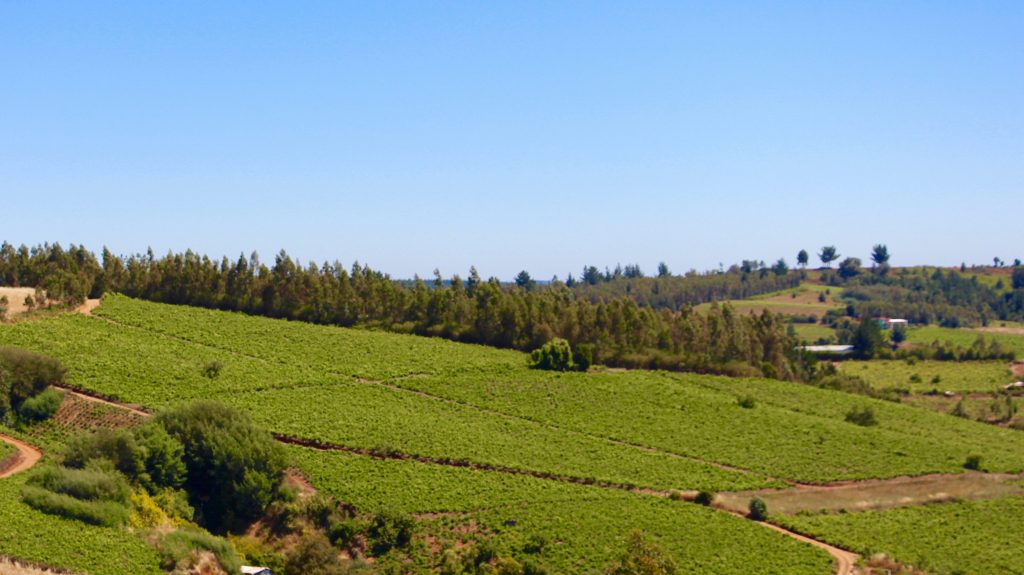In early January of 2017, Andrea and I left Chile’s capital, Santiago, to meet the renowned terroirist Pedro Parra for the first time. Five hours into our drive, we exited Ruta 5 at Chillán to leave Chile’s long Central Valley and drive west, away from the breathtaking Andes, which form the border with Argentina. We continued toward the Pacific Ocean and into the ancient granitic hills of the Itata Valley, a place Pedro claims to be Chile’s promised land.
As we got closer to the Pacific the wind picked up, gusts blowing our car from side to side, slowing us down while the trees lining the highway bent wildly back and forth. As we entered Pedro’s hometown of Concepcion, the summer sky was bright blue and fresh, unlike the gray, smoggy ceiling above Santiago. The further into the city we went the more the wind howled. Along the right bank of the Bio Bio River, we passed through clusters of Chile’s modern commercial buildings, dilapidated midcentury, multicolored apartments and many shanties of the poor (very typical in any Chilean city). Eventually, we found our way to a street corner where we saw a familiar face that we’d only seen in photos.
Standing alongside his German importer, Dirk von Streit (a tall German with Chilean heritage), Pedro immediately extended his hand to me for a warm shake and gave Andrea a big hug. Right away, it seemed like we’d known each other forever. Andrea even joked that maybe I had met her just so I could cross paths with this Chilean scientist, who shared my lifelong fascination with rocks. Every kid has unique interests, and mine happened to be a curious obsession with rocks and seashells. I was so in love with them that when I was about five, I asked an old lady at church who usually wore seashell necklaces and bracelets if I could have them when she died. I’m sure she really appreciated that—at least she smiled.
Andrea drove our car so I could ride with Pedro and start the conversation I’d been wanting to have since I was a boy, and we all headed towards Pedro’s Itata vineyards, about 45 minutes away. In the passenger seat of his SUV was his rock hammer, a tool no geologist or terroir specialist would leave home without. He put on Wayne Shorter and we rolled down the road, windows open because his air conditioner had just broken. We leaned on the center console so we could hear each other over the jazz and the rushing wind, keeping our eyes on the mirrors so we didn’t lose Andrea, following in her mother’s bright red, roller-skate-sized Chinese-made car; it may be one of the slowest new cars in the world, so Pedro took it easy getting into the Itata. He asked me a little bit about myself and I told him the story of how had he foiled my big research plans in Chile…
For quite a while now, I’ve been developing a strong interest in Chile, my wife’s native country. I read about Pedro’s work a number of years ago while researching geological formations in Chile’s cooler southern regions, and years before I discovered him, I visited what was then Chile’s “new frontier” of cold climate terroirs, the Casablanca Valley. The articles about the Casablanca were far more interesting than what I found when I got there. At the time, my opinion was that Casablanca hadn’t even remotely pushed the boundaries of cooler climate grape growing, contrary to what has been written about it in various wine publications.
Pedro stated that it’s actually very easy for wines from Casablanca to ripen to well over 16% alcohol in most years. I was convinced there had to be more interesting soils in significantly cooler areas of Chile, terroirs that could express distinct personalities beyond cellar and vineyard techniques that force wines from uninteresting soils to be something they were never meant to be.
For almost ten years, I had the idea to explore geological formations in the south of Chile and plant experimental vineyard blocks to vinify and isolate high quality terroirs. I was ready to make the move on my project and even got a couple of talented winegrowers interested in joining me. Just when I was ready to pull the trigger, I was stopped short after reading a few articles about Pedro’s work; he was already doing something exactly like what I wanted to do. Besides having the home court advantage, he was far more qualified, holding a Master’s Degree in Precision Agriculture and a PhD where his main focus was terroir. It was bittersweet, but Pedro spared me from a lifetime of research and experimentation.
I let him know just how thrilled I was with his work. He smiled, acknowledging this shared idea—one of a couple of ideas we would come to realize that we shared. “But Chile is deeply wrong with wine.”
Part 2 of 6, “Of Rocks and Wine,” will post next week.
To keep up with this story you can sign up to our email list, or check in next week at the same time and you will find part 2.


